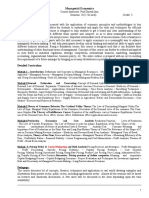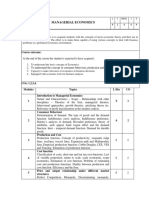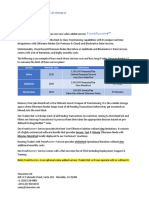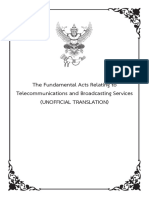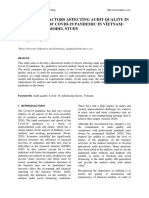Revised CDM
Revised CDM
Uploaded by
induja c mCopyright:
Available Formats
Revised CDM
Revised CDM
Uploaded by
induja c mOriginal Title
Copyright
Available Formats
Share this document
Did you find this document useful?
Is this content inappropriate?
Copyright:
Available Formats
Revised CDM
Revised CDM
Uploaded by
induja c mCopyright:
Available Formats
Academic Year: Course Name with Sub Version No.
COURSE DELIVERY MANUAL
(MBA Programme)
Name of Course with code : : Business economics
Offering Department : MBA
Semester & Programme : 1st
Course Instructor , Department : DR.Madhu.C.S
Academic Year & Batch : 2023- (2021)
: Y
Course project linked (Y/N)
MBA PROGRAM OBJECTIVE STATEMENT
Graduates of the Master of Business Administration degree program of Adi Shankara
Business School, Kalady will be able to: “Integrate tools and concepts from multiple
functional areas such as Finance, Marketing, Operations, HRM, and Systems etc. to
solve business problems. Also they should be able to evaluate and integrate ethical
considerations when making business decisions and develop themselves as business
professionals.
PROGRAM EDUCATIONAL OUTCOMES ( PEO’S)
PEO- 1
Integrate tools and concepts from multiple functional areas such as Finance, Marketing, Operations,
HRM, and Systems etc. to solve business problems.
PEO-2
Students should be able to evaluate and integrate ethical considerations when making business
decisions.
PEO- 3
To develop competent Business Professionals.
PROGRAM OUTCOME
PO-1 Apply Knowledge of management theories and practices to solve business
ADISHANKARA INSTITUTE OF ENGINEERING & TECHNOLOGY, 1
Academic Year: Course Name with Sub Version No.
problems
PO-2 Foster Analytical and Critical thinking abilities for data-based decision making
PO-3 Ability to develop value based Leadership Ability
PO-4 Ability to Understand, Analyze and communicate global, economic, legal and ethical aspects of
Business
PO-5 Ability to lead themselves and others in the achievement of organizational goals, contributing
effectively to team environment.
1. Course Objective
Busineseconomic course is to provide the students an understanding of the growing relevance of economics
in business and corporates and help them to make right decissions.Pre-Requisites: Nil
2. Course Outcome
After the completion of this course, students shall be able to
CO 1 Evaluate the importance of Economics in Business Decisions.
CO 2 Analyse the Demand and Demand Elasticity in varying market conditions.
CO 3 Appraise the Production and Cost Curve in the Short Run and Long Run.
CO 4 Explain Price and Output determination in different Market Structures
CO 5 Evaluate the impact of Monetary Policy Measures and Fiscal Policy Measures and Pricing Strategies of
Small and Large Business Firms.
CO No. Course Outcome Knowledge Level
CO1 Evaluate the importance of Economics in Business Decisions.
CO2 Analyse the Demand and Demand Elasticity in varying market
conditions
CO3 Appraise the Production and Cost Curve in the Short Run
and Long Run.
CO4 Explain Price and Output determination in
different Market Structures
CO 5
Evaluate the impact of Monetary Policy Measures and
Fiscal Policy Measures and Pricing Strategies of Small and
Large Business Firms.
3. CO-PO mapping :
Co’s Po1 Po2 Po3 Po4 Po5
Co1 1 2 1 3 2
ADISHANKARA INSTITUTE OF ENGINEERING & TECHNOLOGY, 2
Academic Year: Course Name with Sub Version No.
Co2 2 2 1 2 3
Co3 3 2 2 2 2
Co4 2 3 2 1 2
Co5 3 2 2 2 2
1-Slightly, 2-Moderately, 3-Strongly
4. CO and Level Mapping
CO’s Bloom Taxonomy
Level’s
CO-1 1
CO-2 2 and 3
CO-3 3
CO-4 4
5. Gap in the Syllabus (Consolidated list of the gaps mentioned in the Syllabus):
Sl No: Description Proposed Actions Relevant
Cos ,Pos
1 Too much theory oriented, need real world
situations
6. Module Outcome Indicators
MOI 1 MOI 2 MOI 3 MOI 4 MOI 5
: INTRODUCTION IDEMAND SUPPLY & MARKET MONETARY POLICY
TO ECONOMICS– ANALYSIS AND PRODUCTION- STRUCTURE - AND FISCAL
Concept of Economics FORECASTING – Law of Supply and Classification of POLICY – Business
and Business EQUILIBRIUM OF Factors Influencing Markets – Markets Cycle-Phase of
Economics, Micro CONSUMER - Supply - Theory of based on Competition - Business Cycle-
Economics and Macro Demand Analysis – Production – Theory of Firm – Profit Concept of Inflation-
Economics, Types of Demand – Production function, Maximization Rules - Types and impact of
Fundamental concepts Law of Demand & Production function Price & Output inflation-Monetary
in economics that aid its Exceptions - with one variable Determination under Policy Measures and
decision making: Elasticity of Demand input – Law of Perfect Competition - Challenges of Monetary
Incremental Principle, – Price Elasticity, Variable Price & Output Policy Measures –
Concept of Cost, Income Elasticity, Proportions – Determination under Fiscal Policy Measures
Discounting Principle, Cross Elasticity, Returns to Scale, Monopoly - Price & and Challenges of
Time Concept, Advertisement Production function Output Determination Fiscal Policy Measures
Concept of Inflation – Elasticity - with two variable under Monopolistic 5B: PRICING
Types and impact of Applications of the inputs – Isoquants – Competition - Price & PRACTICES &
inflation. Equi- concept of Elasticity Isoclines, Collusive Output Determination STRATEGIES -
Marginal Principle –- Demand oligopoly (Cartels, under Oligopoly – Factors affecting Price
ADISHANKARA INSTITUTE OF ENGINEERING & TECHNOLOGY, 3
Academic Year: Course Name with Sub Version No.
9Hours Forecasting – An Price leadership)- Kinked Demand curve Determination – Pricing
20 overview of Producers’ model only (12 Hours) Strategies – Cost
10
Forecasting Equilibrium, CO-4 Oriented Pricing and
CO-1 Techniques – Economies of Scale Conceptual skills Competition Oriented
Analytical thinking, Statistical & Non- – Types – Pricing - Pricing in
decision making capacity Statistical Methods- Economies of Scope large enterprises –
Analysis of ,-Theory of Costs – Pricing in small
Consumer Classification of business. ( (12 Hours)
Equllibrium under Costs – CO-5
Cardinal Utility Determinants of Conceptual thinking
Analysis –Law of Cost - Short Run & -
equi-marginal utility Long Run Cost
– Consumer Curves – Graphical
behaviour under Presentation -
Ordinal Utility Revenue Curves (12
analysis -Indifference Hours) CO-3
Curve Analysis(12 Analytical skill
Hours)
CO 2
Analytical
thinkingEthical Thinking
7. PEDAGOGY
The course will have lectures, case study, assignments, presentations, exercise and secondary
data project to attain the CO’s.
INSTRUCTION TO THE PARTICIPANTS
1- The Participants should go through the course material thoroughly
2- The participants should submit the assignment on the mentioned date.
3- Presentation carry 10 marks- the presentations are evaluated based on the
following norms:
- Conveying the idea 1 Marks
- Group Involvement 1 Marks
- Timely Completion 1 Marks
- Presentation Skills 1 Marks
- Ability to clarify the doubts 1 Marks
4- Two series test will be conducted as per KTU Norms.
5- The assignments will be hand written, using both sides of the page, must not have
copy contains from Internet, one should refer Internet but not COPY-PASTE.
ADISHANKARA INSTITUTE OF ENGINEERING & TECHNOLOGY, 4
Academic Year: Course Name with Sub Version No.
Falling in Plagiarism will be subjected to REPEAT the work.
6- Case Discussion will follow the rules
- Brief History of the cases
- Core issue involved
- Analysis of the issue
- Application of concept in analyzing the case
- Findings and conclusion.
7- Format of writing the paper
Acknowledgements
Abstract
1. Introduction
2. Literature Reviews
3. Proposed Work
4. Problem Definition
5. Solution approach
6. Results and Discussions
7. Conclusions
8. References
9. Pre reading is encouraged.
10. SYLLABUS
Module 1 - INTRODUCTION TO ECONOMICS– Concept of Economics and
Business Economics, Micro Economics and Macro Economics, Fundamental concepts
in economics that aid decision making: Incremental Principle, Concept of Cost,
Discounting Principle, Time Concept, Concept of Inflation –Types and impact of
inflation. Equi-Marginal Principle
\ Module 2 - DEMAND ANALYSIS AND FORECASTING – EQUILIBRIUM OF
CONSUMER - Demand Analysis – Types of Demand – Law of Demand & its
Exceptions - Elasticity of Demand – Price Elasticity, Income Elasticity, Cross Elasticity,
Advertisement Elasticity - Applications of the concept of Elasticity –- Demand
Forecasting – An overview of Forecasting Techniques – Statistical & Non-Statistical
Methods- Analysis of Consumer Equllibrium under Cardinal Utility Analysis –Law of
equi-marginal utility – Consumer behaviour under Ordinal Utility analysis -Indifference
Curve Analysis(12 Hours)
First Internal Examination
Module 3 - SUPPLY & PRODUCTION- Law of Supply and Factors Influencing
Supply - Theory of Production – Production function, Production function with one
variable input – Law of Variable Proportions – Returns to Scale, Production function
with two variable inputs – Isoquants – Isoclines, Collusive oligopoly (Cartels, Price
leadership)-Producers’ Equilibrium, Economies of Scale – Types – Economies of Scope
,-Theory of Costs – Classification of Costs – Determinants of Cost - Short Run & Long
Run Cost Curves – Graphical Presentation - Revenue Curves (12 Hours)
Module 4
MARKET STRUCTURE - Classification of Markets – Markets based on Competition -
Theory of Firm – Profit Maximization Rules - Price & Output Determination under
Perfect Competition -Price & Output Determination under Monopoly - Price & Output
Determination under Monopolistic Competition - Price & Output Determination under
Oligopoly – Kinked Demand curve model only
ADISHANKARA INSTITUTE OF ENGINEERING & TECHNOLOGY, 5
Academic Year: Course Name with Sub Version No.
Module 5 - 5A: MONETARY POLICY AND FISCAL POLICY – Business Cycle-
Phase of Business Cycle-Concept of Inflation-Types and impact of inflation-Monetary
Policy Measures and Challenges of Monetary Policy Measures – Fiscal Policy Measures
and Challenges of Fiscal Policy Measures 5B: PRICING PRACTICES &
STRATEGIES - Factors affecting Price Determination – Pricing Strategies – Cost
Oriented Pricing and Competition Oriented Pricing - Pricing in large enterprises –
Pricing in small business.
11. Final Examination
12. Session Plan – Business Economics
MBA First semester (2023 admission
Session Module Content/key takeaways Instructional Recommended
number number techniques reading
s
1-2 1 INTRODUCTION TO ECONOMICS– Lecture & (B1)
Concept of Economics and Business discussion
Economics, Micro Economics and Macro
Economics,
3-5 1 Fundamental concepts in economics that Lecture & (B1)
aid decision making; discussion
6-9 1 Incremental Principle, Concept of Cost, Lecture & (B1)
Discounting Principle, Time Concept, discussion
Concept of Inflation –Types and impact of
inflation. Equi-Marginal Principle
10 - 12 2 DEMAND ANALYSIS AND Lecture & (B2)
FORECASTING – EQUILIBRIUM OF discussion
CONSUMER - Demand Analysis – Types
of Demand – Law of Demand & its
Exceptions - Elasticity of Demand
13 2 Price Elasticity, Income Elasticity, Cross Lecture & (B1)
Elasticity, Advertisement Elasticity - discussion
Applications of the concept of Elasticity
14 - 16 2 Applications of the concept of Elasticity –- Lecture & (B1)
Demand Forecasting – An overview of discussion
Forecasting Techniques – Statistical &
Non-Statistical Methods
17 2 Case analysis – Lecture & (B1)
discussion
18-19 2 balanced score card; change management. Lecture & (B1)
And case analysis Analysis of Consumer discussion
Equllibrium under Cardinal Utility
Analysis –Law of equi-marginal utility –
Consumer behaviour under Ordinal Utility
analysis -Indifference Curve
- 20 3 SUPPLY & PRODUCTION- Law of Lecture & (B1)
Supply and Factors Influencing Supply - discussion
Theory of Production – Production
function, Production function with one
variable input –
21 3 Iaw of Variable Proportions – Returns to Lecture & (B3)
ADISHANKARA INSTITUTE OF ENGINEERING & TECHNOLOGY, 6
Academic Year: Course Name with Sub Version No.
Scale, Production function with two discussion
variable inputs – Isoquants.
22 - 24 3 Collusive oligopoly (Cartels, Price Lecture & (B1)
leadership)-Producers’ Equilibrium, discussion
Economies of Scale
25 3 Case analyses Lecture & (B3)
discussion
26 - 27 3 Isoclines, Collusive oligopoly (Cartels, Lecture & (B2)
Price leadership)-Producers’ Equilibrium, discussion
Economies of Scale –
28 - 29 3 Classification of Costs – Determinants of Lecture & (B2)
Cost - Short Run & Long Run Cost Curves discussion
– Graphical Presentation - Revenue Curves
30 4 MARKET STRUCTURE - Classification Lecture & (B2)
of Markets – Markets based on discussion
Competition - Theory of Firm – Profit
Maximization Rules
31 - 32 4 - Price & Output Determination under Lecture & (B2)
Perfect Competition -Price & Output discussion
Determination under Monopoly
33 - 35 4 Price & Output Determination under Lecture & (B2)
Monopolistic Competition - Price & discussion
Output Determination under Oligopoly –
Kinked Demand curve model only
36 4 Case analysis Lecture & (B2)
discussion
37 - 38 4 Case analysis Lecture & (B2)
discussion
39 5 ONETARY POLICY AND FISCAL Lecture & (B2)
POLICY – Business Cycle-Phase of discussion
Business Cycle-Concept of Inflation
40 - 41 5 Types and impact of inflation-Monetary Lecture & (B2)
Policy Measures and Challenges of discussion
Monetary Policy Measures
42 - 43 5 Fiscal Policy Measures and Challenges of Lecture & (B2)
Fiscal Policy Measures. discussion
44 - 45 5 PRICING PRACTICES & STRATEGIES Lecture & (B1)
- Factors affecting Price Determination discussion
46 - 47 5 Cost Oriented Pricing and Competition Lecture & (B1)
Oriented Pricing - Pricing in large discussion
enterprises – Pricing in small business.
13. Final
Examin
ation
14. Text Books
–
ADISHANKARA INSTITUTE OF ENGINEERING & TECHNOLOGY, 7
Academic Year: Course Name with Sub Version No.
Component Weight Target CO 1 CO2 CO 3 CO4 CO5
1. age Date Mote V.L.,
Test 1 8 3 3 Paul Samuel,
Gupta G.S. –
Test 2 8 3 3
Managerial
Economics –
Assignment 1 5 2 3 1
TMH New
Delhi
Assignment 2 5 1 3 3
2. Keat, Yong,
&Banarjee –
Course 10 2 2 2 3 3
pjt/seminar/discussion Managerial
Economics:
Attendance and class 4 Economic
participation Tools for
Today’s
Decision Makers – Pearson.
3. Dwivedi D.N – Managerial Economics – Vikas Publications
15. Evaluation
16. CO MAPPING ING EVALUATION
Evaluation Marks CO-1 CO-2 CO-3 CO-4 C0-5
1st Internal 8
2nd Internal 8
Assignment- 1 5
Assignment- 2 5
ADISHANKARA INSTITUTE OF ENGINEERING & TECHNOLOGY, 8
Academic Year: Course Name with Sub Version No.
Project/Presentation 10
Name and Signature of the Course Instructor: Date:
Comments by the Stream Coordinator
Name and Signature of the IQAC Coordinator: Date:
Name and Signature of the HOD: Date:
ADISHANKARA INSTITUTE OF ENGINEERING & TECHNOLOGY, 9
You might also like
- 146E1CDocument3 pages146E1Cdivyabts773No ratings yet
- economics - course outlineDocument3 pageseconomics - course outlineGughapriya VNo ratings yet
- University of Madras: B.B.A. Degree Programme in Business AdministrationDocument3 pagesUniversity of Madras: B.B.A. Degree Programme in Business AdministrationfredrickNo ratings yet
- MBA - SEM 1 - Economic Analysis For Business Decisions - Course SyllabusDocument5 pagesMBA - SEM 1 - Economic Analysis For Business Decisions - Course SyllabusI singNo ratings yet
- 20MB02 - Managerial Economics: To Inculcate The Basic Knowledge About The Concepts of Economics and Managerial EconomicsDocument2 pages20MB02 - Managerial Economics: To Inculcate The Basic Knowledge About The Concepts of Economics and Managerial EconomicssimhamsidduNo ratings yet
- Business EconomicsDocument22 pagesBusiness EconomicsBritneyLovezCandyNo ratings yet
- Managerial Economics and Financial AnalysisDocument11 pagesManagerial Economics and Financial Analysissri varsha vedulaNo ratings yet
- Lesson Plan FinalDocument6 pagesLesson Plan FinalspearstompNo ratings yet
- MBA24103_Managerial Economics (2)Document4 pagesMBA24103_Managerial Economics (2)arkajmaliworkNo ratings yet
- 5_8689ac6f735ee25fc7aeff8f8b8f719bDocument8 pages5_8689ac6f735ee25fc7aeff8f8b8f719bsalmanundikaNo ratings yet
- MecoDocument8 pagesMecosachinkumarmalra792000No ratings yet
- 21PT12-ME Course PlanDocument4 pages21PT12-ME Course PlanSiva SamNo ratings yet
- 349C6ADocument2 pages349C6ACharan TejaNo ratings yet
- 3rd Sem SyllabusDocument32 pages3rd Sem SyllabusRohit ManeNo ratings yet
- 1638684067_Managerial-Economics-and-Financial-AnalysisDocument125 pages1638684067_Managerial-Economics-and-Financial-Analysism.gamingboy204No ratings yet
- MBA Complete Syllabus - CO PO MappedDocument115 pagesMBA Complete Syllabus - CO PO MappedSsamjaNo ratings yet
- Planning at MTCDocument12 pagesPlanning at MTCgsingla802No ratings yet
- Screenshot 2024-03-01 at 9.39.09 AMDocument55 pagesScreenshot 2024-03-01 at 9.39.09 AMRiya JasNo ratings yet
- Bba Semester II SyllabusDocument7 pagesBba Semester II SyllabusJoo NagarajNo ratings yet
- Summer 2020: Principles of Microeconomics ECO101Document4 pagesSummer 2020: Principles of Microeconomics ECO101A. Z. M Tanvir ShahriarNo ratings yet
- SyllabusDocument3 pagesSyllabusadrinavictoria06No ratings yet
- Bms 3rd Sem FinalDocument39 pagesBms 3rd Sem FinalTejas NandanNo ratings yet
- Academic Dairy: II Semester II Semester II Semester II SemesterDocument11 pagesAcademic Dairy: II Semester II Semester II Semester II SemesterIndra SekharNo ratings yet
- Syllabus OldDocument165 pagesSyllabus Oldumesh1374No ratings yet
- MR Unit 3 DigiDocument66 pagesMR Unit 3 DigiBhavani SureshNo ratings yet
- A Course Outline 2023-24Document10 pagesA Course Outline 2023-24ankit aggarwalNo ratings yet
- Handouts For Accounting For Decision MakingDocument3 pagesHandouts For Accounting For Decision MakingSneha SnehaNo ratings yet
- Syllabus - Industry and Competitive AnalysisDocument6 pagesSyllabus - Industry and Competitive AnalysisghulamazkaalimNo ratings yet
- Adobe Scan 03 Sept 2024Document8 pagesAdobe Scan 03 Sept 2024backup927098No ratings yet
- Semester IIDocument20 pagesSemester IIanupriya3771No ratings yet
- Bba III Sem SyllabusDocument13 pagesBba III Sem SyllabusaromoishaNo ratings yet
- Managerial Economics NIAMDocument2 pagesManagerial Economics NIAMStan leeNo ratings yet
- Course CurriculumDocument3 pagesCourse CurriculumSHEKHAWAT FAMILYNo ratings yet
- Bms 2nd Sem FinalDocument17 pagesBms 2nd Sem FinalTejas NandanNo ratings yet
- Gujarat Technological University MAM (Masters in Applied Management) - Dual Degree Programme Semester - IVDocument2 pagesGujarat Technological University MAM (Masters in Applied Management) - Dual Degree Programme Semester - IVSabhaya ChiragNo ratings yet
- IV GEN MergedDocument78 pagesIV GEN Mergedcboy41404No ratings yet
- MecoDocument4 pagesMecousamaNo ratings yet
- ECODocument3 pagesECOVikasNo ratings yet
- Tlaw189l Managerial-Economics TH 1.0 0 Tlaw189lDocument2 pagesTlaw189l Managerial-Economics TH 1.0 0 Tlaw189lShreyaah TSNo ratings yet
- Sem2 Core SyllabusDocument19 pagesSem2 Core SyllabusNIMISHA DHAWANNo ratings yet
- CIM Syllabus 2nd SemeterDocument65 pagesCIM Syllabus 2nd Semetercdaz897No ratings yet
- Fybim - Revised SyllabusDocument50 pagesFybim - Revised Syllabusnishchalshetty1323No ratings yet
- Economics for Decision makingDocument5 pagesEconomics for Decision makingindratej301No ratings yet
- Course Outline - Managerial EconomicsDocument6 pagesCourse Outline - Managerial EconomicsParvathaneni KarishmaNo ratings yet
- Ient1031 Managerial EconomicsDocument2 pagesIent1031 Managerial Economicsvishuramini015No ratings yet
- CA5102 Course-Plan Managerial-EconomicsDocument12 pagesCA5102 Course-Plan Managerial-EconomicsJean MaeNo ratings yet
- MADM Course Outline 2020 - 21 - v2Document6 pagesMADM Course Outline 2020 - 21 - v2KaranNo ratings yet
- 2021 - Me - Course Pack Final VersionDocument9 pages2021 - Me - Course Pack Final VersionVimal SharmaNo ratings yet
- Question BankDocument2 pagesQuestion BankRishbah TyagiNo ratings yet
- Business ValuationsDocument5 pagesBusiness ValuationsCarrots TopNo ratings yet
- mefa syllabus 1Document1 pagemefa syllabus 1manasapNo ratings yet
- MBEM613 - Course OutlineDocument4 pagesMBEM613 - Course OutlineIkmal KhairiansaNo ratings yet
- Fundamentals of Financial Management - Preetha ChandranDocument7 pagesFundamentals of Financial Management - Preetha ChandranAditya KumarNo ratings yet
- LAW1301 - MANAGERIAL-ECONOMICS - TH - 1.1 - 0 - LAW 1301 - Managerial EconomicsDocument2 pagesLAW1301 - MANAGERIAL-ECONOMICS - TH - 1.1 - 0 - LAW 1301 - Managerial EconomicssNo ratings yet
- 150C2B Madras UniversityDocument3 pages150C2B Madras Universityriharajput88No ratings yet
- Economics For ManagementDocument3 pagesEconomics For ManagementRaman KumarNo ratings yet
- Micro Economics Analysis ECOCC201 Course File M A ECO 2022-23Document36 pagesMicro Economics Analysis ECOCC201 Course File M A ECO 2022-23gsmoneymoneyNo ratings yet
- UNIT-1to3 QB-economicsDocument75 pagesUNIT-1to3 QB-economicsthillikkaniNo ratings yet
- Mechanics Module 3Document32 pagesMechanics Module 3induja c mNo ratings yet
- Mechanics Module 4Document18 pagesMechanics Module 4induja c mNo ratings yet
- Morden Physics 3Document4 pagesMorden Physics 3induja c mNo ratings yet
- Morden Physics 2Document5 pagesMorden Physics 2induja c mNo ratings yet
- Module 05 Developmental Process - Western and Eastern PerspectivesDocument2 pagesModule 05 Developmental Process - Western and Eastern Perspectivesinduja c mNo ratings yet
- Module 04 Stress According To Eastern PerspectiveDocument3 pagesModule 04 Stress According To Eastern Perspectiveinduja c mNo ratings yet
- Module 02 Introduction To Yoga For Stress Management - 2Document2 pagesModule 02 Introduction To Yoga For Stress Management - 2induja c mNo ratings yet
- Alcohols Phenols & Ethers Notes PDFDocument83 pagesAlcohols Phenols & Ethers Notes PDFinduja c mNo ratings yet
- Answer and Solutions - JEE - Main 2023 - PH 1 - 25 01 2023 - Morning - Shift 1 PDFDocument25 pagesAnswer and Solutions - JEE - Main 2023 - PH 1 - 25 01 2023 - Morning - Shift 1 PDFinduja c mNo ratings yet
- 12 Chemistry Notes ch13 AminesDocument11 pages12 Chemistry Notes ch13 Aminesinduja c mNo ratings yet
- Answer and Solutions - JEE - Main 2023 - PH 1 - 24 01 2023 - Evening - Shfit 2 PDFDocument24 pagesAnswer and Solutions - JEE - Main 2023 - PH 1 - 24 01 2023 - Evening - Shfit 2 PDFinduja c m100% (1)
- Equirus 3 Year Top Ideas Note 15.09.2022Document96 pagesEquirus 3 Year Top Ideas Note 15.09.2022Harshika MehtaNo ratings yet
- POWER INFRASTRUCTURE Wrap Up 2018 2019Document100 pagesPOWER INFRASTRUCTURE Wrap Up 2018 2019Abdul RBed IsaNo ratings yet
- Business Ethics Lecture NotesDocument84 pagesBusiness Ethics Lecture NotesAldwin CalambaNo ratings yet
- LGT - Outlook For Supply Chain and Logistics ManagementDocument4 pagesLGT - Outlook For Supply Chain and Logistics ManagementWency Bringino Alterado NarvaezNo ratings yet
- Types of AuditDocument6 pagesTypes of Audit2kd TermanitoNo ratings yet
- Analyzing and Visualizing Data With Excel 2016Document19 pagesAnalyzing and Visualizing Data With Excel 2016tahsin çetinkayaNo ratings yet
- Points For Asset Management in SAP S - 4HANA 2021Document42 pagesPoints For Asset Management in SAP S - 4HANA 2021manjus4hana2022No ratings yet
- Negotiable Instruments LawDocument9 pagesNegotiable Instruments LawjannahNo ratings yet
- The Impact of Covid-19 ENGLISHDocument14 pagesThe Impact of Covid-19 ENGLISHNilton ValdimiroNo ratings yet
- FINAL Phase II - Title Report 2023Document85 pagesFINAL Phase II - Title Report 2023AtulNo ratings yet
- IFB Mock - Spring-24Document2 pagesIFB Mock - Spring-24syedameerhamza762No ratings yet
- Attock Refinery LimitedDocument26 pagesAttock Refinery LimitedRehan Shahzad RajaNo ratings yet
- Adfl Corporate BrocheureDocument6 pagesAdfl Corporate Brocheurepranjal92pandeyNo ratings yet
- Book Review: The Wit and Wisdom of Steve Jobs by Gennaro SalamoneDocument15 pagesBook Review: The Wit and Wisdom of Steve Jobs by Gennaro SalamoneMarina SeleznevaNo ratings yet
- Competitor Strategies in Alcoholic DrinksDocument37 pagesCompetitor Strategies in Alcoholic DrinksJimenez Vargas Jorge AntonioNo ratings yet
- Xrisa CVDocument1 pageXrisa CVxrisa.steffoxNo ratings yet
- Cash Flow Statement ProblemsDocument11 pagesCash Flow Statement ProblemsRaman SachdevaNo ratings yet
- CCS Timing Technical White PaperDocument11 pagesCCS Timing Technical White PaperStudentNo ratings yet
- Texnomic Tradex Bot: Announcement #3Document1 pageTexnomic Tradex Bot: Announcement #3lawNo ratings yet
- Sept 2021 Insight PartiiDocument133 pagesSept 2021 Insight Partiirowan betNo ratings yet
- PIF-14-PCA-01 PunchlistDocument2 pagesPIF-14-PCA-01 PunchlistJeziel BayotNo ratings yet
- BSBFIN501 Student Assessment TasksDocument25 pagesBSBFIN501 Student Assessment TasksCIARA SUBANo ratings yet
- The Fundamental Acts Relating To Telecommunications and Broadcasting Services (Unofficial Translation)Document304 pagesThe Fundamental Acts Relating To Telecommunications and Broadcasting Services (Unofficial Translation)ArkNo ratings yet
- Leasing HireDocument16 pagesLeasing Hirerings rockNo ratings yet
- Nikita Writing Instruments Strapping MachinesDocument1 pageNikita Writing Instruments Strapping MachinesASA PolyPlastNo ratings yet
- Sec 19 (3) Employer AppointmentDocument2 pagesSec 19 (3) Employer AppointmentmimiNo ratings yet
- JPSP 2022 019Document9 pagesJPSP 2022 019AGBA NJI THOMASNo ratings yet
- e-Governance-Compiled Lecture Notes by Tilahun SDocument27 pagese-Governance-Compiled Lecture Notes by Tilahun SabiyNo ratings yet
- Case Study 2 - NetflixDocument13 pagesCase Study 2 - NetflixLeilani GaniNo ratings yet
- Ent300 Business Plan For Travel AgencyDocument34 pagesEnt300 Business Plan For Travel Agencyvanaja pareeNo ratings yet































